Company news
Shipowners are in a strategic dilemma: Soaring shipbuilding costs and decarbonization pressure coexi

Recently, DNV, a world-leading classification society, pointed out at the SMM Hamburg exhibition that the uncertainty in the European shipping industry is leading to a sharp increase in the price of new ships. For shipowners, how to achieve decarbonization goals and update the fleet under the current high shipbuilding costs has become a primary problem.
“At the moment, many shipowners are in a strategic dilemma. Perhaps they have been waiting and delaying fleet renewal, and now have to renew their fleet at the current high prices,” Rasmus Stute, DNV’s regional manager for Germany, said at the SMM Hamburg show.
The problem is exacerbated by a shortage of shipyard slots, with few existing sites pushing up prices, while labor shortages and uncertainty about future fuels continue to drive up shipbuilding costs.
Rasmus Stute also stressed that the shortage of skilled labor cannot be ignored, especially considering that ships using new fuels such as methanol or ammonia will require additional certification in the future.
“However, building new ships alone is not enough to solve the decarbonization problem in the shipping industry,” he further explained. “At any given time, only 10% of ships are newbuildings, which means that 90% of the existing fleet needs to be decarbonized in service. Updating the engines of all ships is not an economically viable option, so the application of energy-saving technologies will be key.”

This has become a heavy financial burden for many small and medium-sized shipowners. The cost of replacing the engines of existing ships is too high, and the application of energy-saving technologies and emission control devices also requires huge capital investment. It is difficult for shipowners to see a clear return in the short term.
Regarding the cost of decarbonization, Rasmus Stute called for a level playing field for all market participants on a global scale. “IMO must develop global emission rules, otherwise this will put some market participants at a disadvantage.”
Driving the decarbonization of the shipping industry on a global scale is an expensive task, and who will ultimately bear the cost is one of the most controversial topics at the moment. Rasmus Stute advocates a solution based on a price mechanism, whereby funds are raised through “fines” on CO2 emitters, which are then distributed to companies using more environmentally friendly fuels. “In this way, environmentally friendly companies will receive a form of reward, while companies that emit more will have to pay a high price. Ultimately, transportation costs are bound to rise, and this will be passed on to consumers through the supply chain. But at the end of the day, this is the world we live in, so maybe it’s worth it.”

When asked by his colleague Norbert Kray, DNV Greater China Regional Manager, whether he is optimistic about the new ammonia fuel, Rasmus Stute admitted that ammonia fuel will play an important role in the future because it does not produce carbon emissions when burned. "But ammonia fuel requires a specific storage method. Although it is technically feasible, it is more expensive. However, once heavy fuel oil is taxed, ammonia fuel will become a more competitive option."
Faced with the current strategic dilemma, shipowners need to find a way out of uncertainty. On the one hand, waiting for the market to become clearer will prolong the decision-making time, but this may miss the current limited space resources; on the other hand, premature investment may bring huge financial risks, especially when fuel technology and policies are still unclear.
In the future, with the introduction of IMO global emission standards, the clarification of fuel tax policies, and the maturity of alternative fuel technologies such as methanol and ammonia, the strategic dilemma of the shipping industry may be gradually solved. But before that, shipowners need to make careful choices in a complex market environment and weigh the relationship between cost and environmental protection in order to gain an invincible position in the global shipping market.